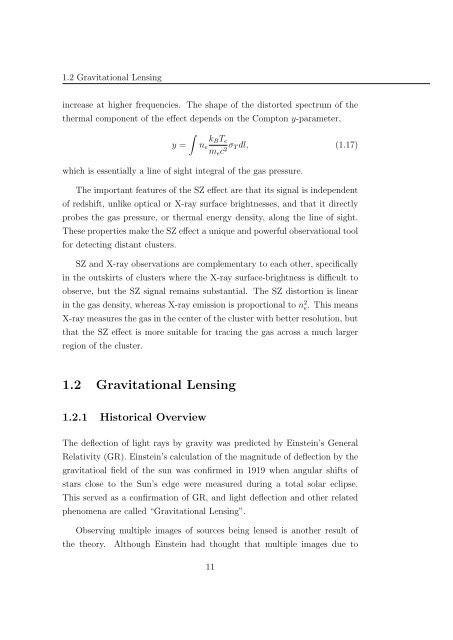Mass and Light distributions in Clusters of Galaxies - Henry A ...
Mass and Light distributions in Clusters of Galaxies - Henry A ...
Mass and Light distributions in Clusters of Galaxies - Henry A ...
You also want an ePaper? Increase the reach of your titles
YUMPU automatically turns print PDFs into web optimized ePapers that Google loves.
1.2 Gravitational Lens<strong>in</strong>g<br />
<strong>in</strong>crease at higher frequencies. The shape <strong>of</strong> the distorted spectrum <strong>of</strong> the<br />
thermal component <strong>of</strong> the effect depends on the Compton y-parameter,<br />
∫<br />
y =<br />
n e<br />
k B T e<br />
m e c 2 σ T dl, (1.17)<br />
which is essentially a l<strong>in</strong>e <strong>of</strong> sight <strong>in</strong>tegral <strong>of</strong> the gas pressure.<br />
The important features <strong>of</strong> the SZ effect are that its signal is <strong>in</strong>dependent<br />
<strong>of</strong> redshift, unlike optical or X-ray surface brightnesses, <strong>and</strong> that it directly<br />
probes the gas pressure, or thermal energy density, along the l<strong>in</strong>e <strong>of</strong> sight.<br />
These properties make the SZ effect a unique <strong>and</strong> powerful observational tool<br />
for detect<strong>in</strong>g distant clusters.<br />
SZ <strong>and</strong> X-ray observations are complementary to each other, specifically<br />
<strong>in</strong> the outskirts <strong>of</strong> clusters where the X-ray surface-brightness is difficult to<br />
observe, but the SZ signal rema<strong>in</strong>s substantial. The SZ distortion is l<strong>in</strong>ear<br />
<strong>in</strong> the gas density, whereas X-ray emission is proportional to n 2 e. This means<br />
X-ray measures the gas <strong>in</strong> the center <strong>of</strong> the cluster with better resolution, but<br />
that the SZ effect is more suitable for trac<strong>in</strong>g the gas across a much larger<br />
region <strong>of</strong> the cluster.<br />
1.2 Gravitational Lens<strong>in</strong>g<br />
1.2.1 Historical Overview<br />
The deflection <strong>of</strong> light rays by gravity was predicted by E<strong>in</strong>ste<strong>in</strong>’s General<br />
Relativity (GR). E<strong>in</strong>ste<strong>in</strong>’s calculation <strong>of</strong> the magnitude <strong>of</strong> deflection by the<br />
gravitatioal field <strong>of</strong> the sun was confirmed <strong>in</strong> 1919 when angular shifts <strong>of</strong><br />
stars close to the Sun’s edge were measured dur<strong>in</strong>g a total solar eclipse.<br />
This served as a confirmation <strong>of</strong> GR, <strong>and</strong> light deflection <strong>and</strong> other related<br />
phenomena are called “Gravitational Lens<strong>in</strong>g”.<br />
Observ<strong>in</strong>g multiple images <strong>of</strong> sources be<strong>in</strong>g lensed is another result <strong>of</strong><br />
the theory. Although E<strong>in</strong>ste<strong>in</strong> had thought that multiple images due to<br />
11
















